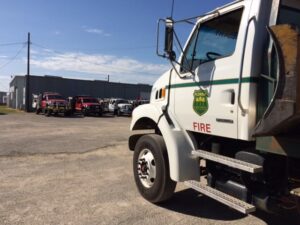 Again. It happened again. Twice in five years fire gobbled up trees, pastures, and homes outside of Smithville, Texas, my hometown. Nearly 5,000 acres and 40 structures burned, are today’s numbers. Fire trucks bearing names like Gonzales, Bryan, Sequin, Nacogdoches, and San Antonio park next to six backhoes on flatbed trucks from as far away as Florida. Chinook helicopters carrying red bags of water – liquid hope – careen over the ridge to the front line. A DC10 from Tennessee drops red fire retardant across angry burning pine trees. This is the activity of the fire. But, it’s the impact on people where the real destruction occurs.
Again. It happened again. Twice in five years fire gobbled up trees, pastures, and homes outside of Smithville, Texas, my hometown. Nearly 5,000 acres and 40 structures burned, are today’s numbers. Fire trucks bearing names like Gonzales, Bryan, Sequin, Nacogdoches, and San Antonio park next to six backhoes on flatbed trucks from as far away as Florida. Chinook helicopters carrying red bags of water – liquid hope – careen over the ridge to the front line. A DC10 from Tennessee drops red fire retardant across angry burning pine trees. This is the activity of the fire. But, it’s the impact on people where the real destruction occurs.
Coincidently, I recently met a transportation colleague who lost her home in the last fire in the neighboring city of Bastrop. She relocated to another part of the state. I talked with her as the Smithville (Hidden Pines Fire) threatened more homes. She described their loss and the different ways she and her husband managed the situation. She described how she wanted to “dig in,” get her hands dirty and help stop the fire that changed their world. Her husband, on the other hand, wanted to get away from the destruction, the remnants of their home, and start anew. Others here share that predicament.
While there is no comparison between the personal devastation of a fire, there are lessons for the work environment. Sometimes we want to flee a stressful situation but struggle with the decision. We are unhappy with a stressful work situation but we don’t want to be a “quitter.” This can be a difficult decision for anyone, but it’s so important that people put their health first. If the workplace is not a nice environment, then it might be worth leaving. For example, there are times when a toxic leader creates a fire that threatens your self-esteem and self-confidence. Here are five factors to consider when deciding if it’s time to go.
Attempts to communicate with the person creating the fire are unsuccessful. Before giving up, we must first take responsibility for attempting to work things out with the person who is creating the heat. Using honest communication, make an effort to express concerns in a constructive way and take responsibility for your part of the communication breakdown. Offer ideas for constructively moving forward. Years ago, I worked for a boss who made every day feel like a fire. I made several attempts at honest and open discussion. Each time I thought we made progress I got burned again within a couple of days when a hot-spot flared up from him.
To reframe the problem is not sustainable. There are times when our perceptions about the situation or person are partly to blame. It is worth asking yourself if there are other ways to view the problem. Neuroscientists call this technique “reframing.” It is trite to say that each problem is an opportunity; however, a difficult person may block one path that opens your eyes to a different approach. You reframe the way you approach your work. In my case, I looked for every angle and tried to separate triggered feelings from my work. It takes mental energy to reframe a situation and because this fire was so persistent, I was exhausted trying to support a reframed viewpoint.
The level of stress is all-consuming. Stress has mental and physical ramifications. We all dread work on some days, and some days are more high-pressure than others. That is something experienced in many different places of work. For those cases, it might be worth seeing if remedies such as Delta 8 THC or CBD could make a difference. These are said to have a significant effect on stress levels, as well as come in many different forms that are easier to use or consume. Extracurricular activities like yoga or tai chi are also said to be effective in combatting stress and allowing people to cope in the workplace.
BUT (and this is a BIG but) it’s different to feel physically ill or to experience signs of stress-induced illness (a friend breaks out in a rash, for example). Panic attacks on the ride to work are also a major concern. Moreover, if every night is filled with torment, or filled with disturbing dreams, it is a sign to be taken seriously. I vividly recall a dream of pushing my staff in a life raft across a river while being shot in the back with arrows from people on the shore. The dream was not ambiguous!
Support systems are not enough. Counseling services and coaches are assets in difficult situations. An objective observer sees other points of view and may offer insights not obvious to you. These people are like the support agencies with vans parked around Smithville during the fire to assist residents and get them through the disaster. There is no better time to take advantage of these resources than during your own personal office “fire.”
I had the assistance of an executive coach and it was invaluable. Also, in the event of an office fire, it is essential that there is something like an assessment template for COSHH, so the dangers have been evaluated within the building and an evacuation plan has been made.
There is no end in sight. You must assess the duration of the situation and decide if it’s worth sticking it out. While I tried each of the approaches above, none worked. The only reason I stayed in my position was with the knowledge that this boss’s days were numbered. Had there been no end in sight, I would have re-evaluated my decision.
There are times when the work situation cannot be fixed. Just as my friend’s husband needed to get away, you may need to flee a toxic, non-reparable work situation. And it’s okay…actually, it’s the wisest course of action to preserve your sense of self. When the fire in the office can’t be put out, you need to evacuate before it destroys you. These five factors are good indicators.
I struggle to make sense of all that I’ve seen in Smithville this week, but perhaps that, too, is indicative of the situation. It takes time to process trauma and to come to grips with the loss. And it’s not clear that it ever makes sense. In closing, it is important to thank the firefighters, agencies, pilots and volunteers who saved so many from having to make tough choices about their future. Because of them, friends continue to be neighbors.





0 Comments